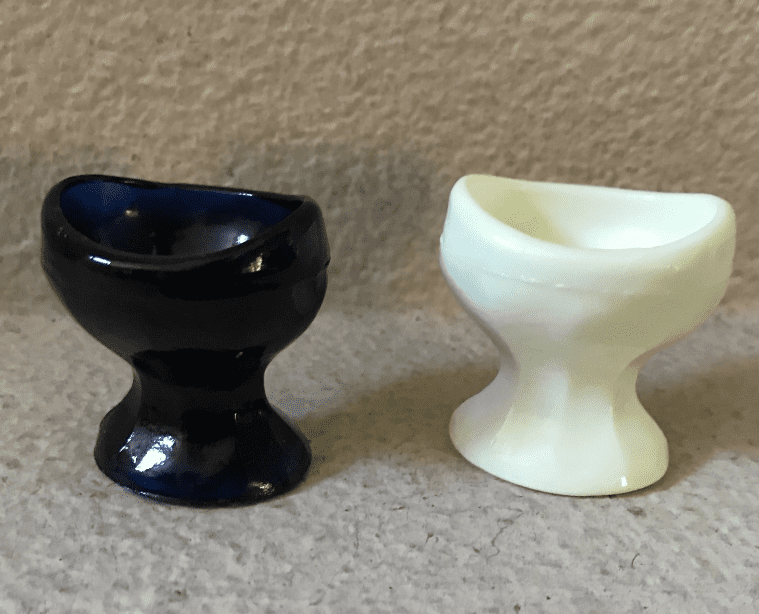Introduction: In this article – part of an ongoing “Introduction to Genealogy” series – Gena Philibert-Ortega gives tips for identifying the family heirloom that was handed down to you. Gena is a genealogist and author of the book “From the Family Kitchen.”
I have been fortunate to have people show me their family heirlooms and ask if I know anything about them. I’ve researched everything from quilts and dresses to kitchen tools and dishes. I love this type of treasure hunt – and to be honest, it seems that my parents’ hobby of antique shopping when I was a kid has benefitted me. Afterall, what better place to learn history than an antique store?
What heirlooms do you or your family have that make you scratch your head? How can you identify something you inherited? Let’s use an item from my family to help us think about how we can identify family heirlooms.
What Is That?
Consider these objects from my mom’s collection. These two items stand about 1½ inches tall and have a bowl that is about 1 inch, but some of these items can also be taller than the examples I’m showing. These particular examples are made of glass, but my mom also has some that are made of plastic.

Online Searching
If I had no idea what these items were, it would be difficult to just “Google it” hoping for a quick answer. What keywords would I use that would make sense? If I wanted to try a Google search, I should come up with a hypothesis for what I think these items could be, what they were used for, or where they were used (for example, the kitchen) that might help me to describe them in an online search. I may decide to use what little I do know to start my search. For example, typing in the name of any manufacturer or other clues found on the items may help. Unfortunately, in this case there are no identifying marks or manufacturer names on these two items.
What else could I try? I could seek out reference guides or relevant websites. Antique price guides and vintage Sears Catalogs may help. Finding similar items on eBay or Pinterest would also be helpful – but once again, I need to have words to describe these items to search those websites.
One other technique you could use to identify an unknown item is to use a reverse image search via Google Images. A “reverse image search” is when a search engine uses an image instead of keywords to find matches. To do this, go to Google Images and click on the camera icon in the search engine box. Now upload an image of the item. Google will search for other images that match the one you uploaded. This might help you to find matching images which can lead to more information.
Family and Friends
I could start my research by asking my family what they think these items are and if they knew the use/importance of them. If that didn’t result in an answer, I could crowdsource the question to my friends on social media websites Facebook and Twitter. I have crowdsourced problems on social media before and this can be very helpful. I could also post a photo of these items on my blog or website hoping a reader might have an answer.
The Archive Lady, Melissa LeMaster Barker, recommends asking your local museum or historical society about your item. They can help you identify it or make suggestions. I would also suggest local antique stores since the people who work and sell there have a special interest in vintage items and may specialize in your particular item.
That’s What It Is!
So, by searching online and asking around, you now know what the item is. Next, use old newspapers, such as GenealogyBank’s Historical Newspaper Archives, to learn more about it. Consider newspaper articles such as advertisements, collector columns, or anything that might describe using that item.
In the example from my mom’s collection, the photo shows two eye wash cups. It seems that when my mom started collecting these, about the 1980s, other collectors were curious about the medical item and started seeking them out as well.
Delving further back in the historical newspapers, I get a sense of why eye wash cups were so important to generations past. Today the importance of washing your eyes seems to be limited to removing foreign objects or liquids from the eye, but generations previous saw eye washing as part of their overall beauty regime.
Here’s a 1917 “Beauty Chats” newspaper column explaining that “daily eye wash increases the beauty of the eye.” You could purchase eye wash, but this article suggests that the “best wash is made from pure water – boiled water is pure – and boric acid.”
This article includes an image of a woman using an eye wash cup.
My favorite of the articles on eye washing is this one that proclaims “No Woman Can Be Really Beautiful Who Neglects This Most Important of Duties.” This newspaper article instructs that “The eye bath should be taken in the morning and before retiring. The eye cup fits over the open eye and the water will wash it out.” It also says to use a “pinch of salt.” However, I’m not so sure I’d want to add even diluted salty water to my eye.
Collyrium was an eye wash liquid that your ancestor may have purchased.
In the product shown above, the bottle cap was replaced with an eyewash cup.
Learn More about That Heirloom Today
Family members die, and with them their life experiences and stories. Often, we don’t understand what was important to them or why they saved certain items or found joy in material items that we don’t use anymore. Not sure what that heirloom is? You can figure it out by using crowdsourcing, reference works, and historical newspapers. Then use what you learned to tell the story of that item and your ancestor.
Related Articles:
